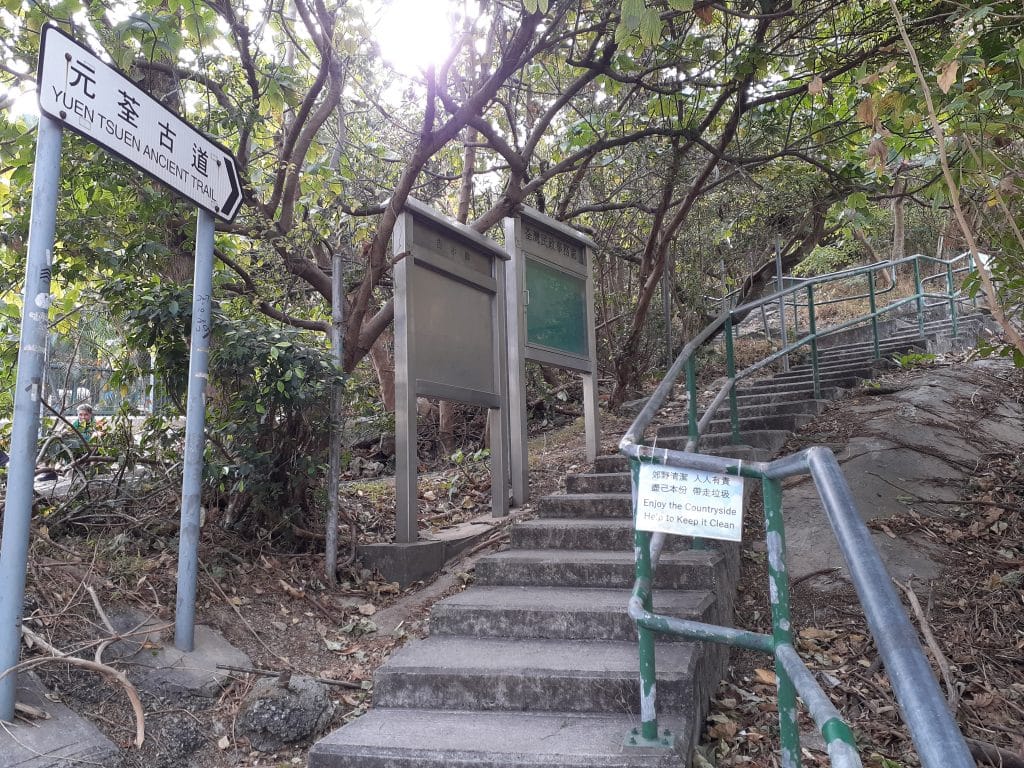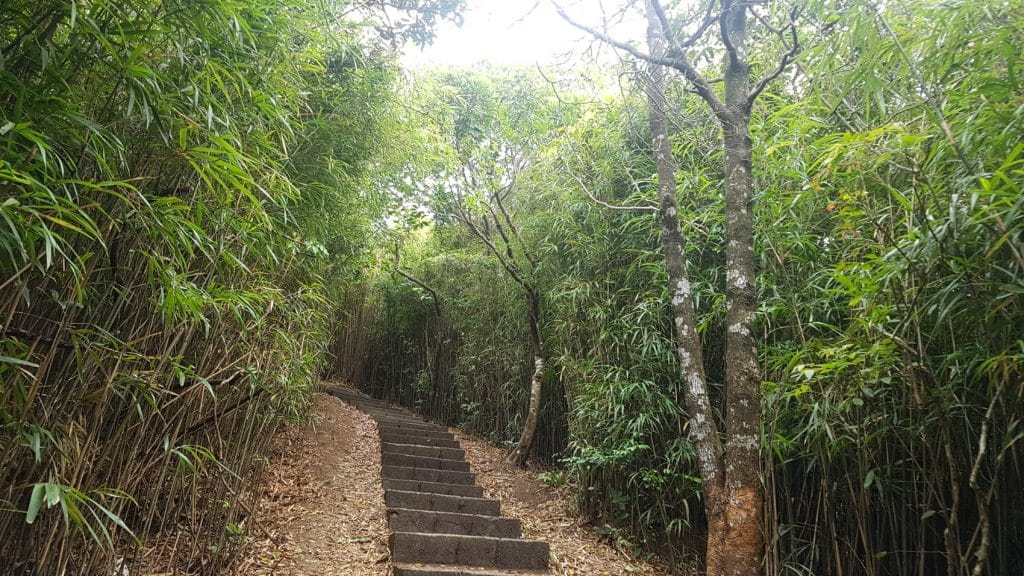The bustling metropolis of Hong Kong boasts a diverse and stunning natural landscape, with numerous hiking trails that attract both locals and tourists. In recent years, a number of environmental groups and NGOs have raised concerns about the widespread use of concrete in trail management in Hong Kong. Concrete, a popular and resource-intensive construction material, is associated with habitat destruction and other environmental issues. In a conversation with Earth.Org, Agnes Cheng from the Concern Group on Concretisation and Vivien Cheng from Hong Kong-based non-profit Green Earth shared how they advocate for sustainable trail management and successfully get both citizens and the government involved in awareness and conservation campaigns.
—
Hong Kong, a city renowned for its stunning skyline and bustling urban environment, is also home to a remarkable natural landscape that often surprises visitors. With a distinct blend of high-rise skyscrapers, lush mountains, and picturesque coastlines, the city presents a unique juxtaposition of urban development and natural beauty. Rather than skyscrapers dominating the landscape, as one would expect when visiting one of the world’s most densely populated cities, Hong Kong resembles a dense forest interspersed with clusters of towering buildings. Home to 24 country parks, 22 special areas, and eight marine parks and reserves – which make up about 40% of the city’s land area – the city offers great opportunities for outdoor exploration and scenic escapes.
Unfortunately, the rapid pace of construction and urban government projects over the years have left a significant mark on the city’s hiking trails. Concrete paths for access and maintenance purposes have rapidly replaced the untouched terrain that once defined these outdoor havens, giving rise to unique challenges.
While concrete looks like a convenient solution, it has serious long-term repercussions on the environment, often giving a “false sense of permanence,” explained Agnes Cheng, co-founder of the Concern Group on Concretization of Hong Kong Natural Trails.
The conservation initiative was established in 2016 by a small group of community volunteers led by amateur trail running athlete Stone Tsang as a social media campaign. It has since expanded to a network of more than 100 volunteers and more than 8,000 followers dedicated to raising awareness about the negative impact of concrete on natural trails and promoting trail conservation and responsible use. In recent years, the Group has engaged with government departments, NGOs, and conservation experts to identify trail management issues and advocate for more sustainable solutions.
The Beginnings
The Concern Group on Concretisation beginnings coincided with a large-scale renovation project of the Yuen Tsuen Ancient Trail, a major trading route connecting the two major towns Yuen Long and Tsuen Wan in the New Territories in northwestern Hong Kong. For centuries, people commuted between the two towns by walking across a treacherous mountain. Nowadays, the trail is a well-paved, 12.5km concrete path with rest pavilions, picnic spots, and camping grounds along the way.
“I’ve been following Stone on social media for a long time, I’m a big fan,” said Cheng, herself an experienced trail runner. “One day, he started talking about the Yuen Tsuen Ancient Trail renovation project the government was working on, explaining that, instead of renovating it, they had completely replaced the natural path with a paved path built mainly with concrete and stones.”
Concrete paving has been a common approach for trail renovation projects in Hong Kong for decades. For example, the extent of concretisation of the 100-kilometre long MacLehose Trail, Hong Kong’s oldest trail, is 50%.
The situation abroad is fairly different.
Recalling her trips to France and Japan, Cheng said that while people in Hong Kong take concrete paths for granted, she had almost never seen concrete stairs or paved paths abroad. “When I went to Japan, I learned from the locals that Mount Fuji is unpaved because people see mountains as a very sacred place. And that made me think: ‘Why can it not be the same in Hong Kong?’”
Tsang’s appeals on social media to stop the renovation of the Yuen Tsuen Ancient Trail marked the first time such practice was openly and widely criticised in Hong Kong. “It was very enlightening,” said Cheng.
Shortly after that, herself, Tsang, and two friends and fellow hikers joined forces to work on a mission: convince the government to change practice.

What’s Wrong With Concrete?
Concrete represents about 35-40% of all material consumption by mankind, second only to water. If the cement industry was a country, it would be the third-largest carbon dioxide emitter in the world, surpassed only by China and the US.
According to a 2018 report by the Organisation for Economic Co-operation and Development (OECD), global cement demand will rise to substantially more than 60 billion tons per year in 2050, while consumption is expected to double. After all, for centuries, concrete has been the basic material for all types of construction, including housing, roads, schools, hospitals, dams and ports, for decorative applications such as patios, floors, staircases, driveways, and pool decks, as well as for items like tables, sculptures, or bookcases.
Though many do not realise it, there is a dark side to it. For a starter, the production of concrete involves the extraction of raw materials like limestone, clay, and sand from the Earth, a resource-intensive process that can lead to habitat destruction, soil erosion, and disruption of ecosystems. Manufacturing of concrete also requires a significant amount of energy, making it the most energy-intensive of all manufacturing industries.
In the case of trails, Cheng explained that problems arise even before the actual building of a concrete path.
“Let’s say the government needs to build a 15-metre concrete staircase on a slope to facilitate access to a remote village. Very often, whole patches of soil, usually double or even triple the staircase width, are removed to facilitate the transportation of concrete to the building site,” she explained.
“The problem is that once you remove the topsoil, vegetation doesn’t come back as you have erosion happening on both sides of the concrete path.”

Besides destroying the natural landscape and the species that inhabit it, concrete paths are very hard on the knees and generally an unhealthy and unattractive option for hikers and trail runners, explained Cheng, who recalled how many trails in Hong Kong become slippery and unstable when it rains. What’s more, contrary to what most people think, concrete is susceptible to weathering and erosion, especially in harsh climates. Exposure to freeze-thaw cycles, extreme temperatures, high humidity, and acidic rain can gradually wear down the surface of the concrete, making repair works a regular occurrence.
‘A Very Standardised Process’
The strong desire to advocate for better and more sustainable practices convinced the four friends that the only way to change these environmentally problematic practices was to speak directly to those in charge.
“When we first contacted the AFCD [Hong Kong’s Agriculture, Fisheries and Conservation Department], we were surprised to find that they had already been exploring the same questions that we were raising. However, they lacked the know-how,” explained Cheng.
The department’s openness to exploring more sustainable alternatives was the main driver behind a years-long collaboration between the Concern Group and the government. Ever since 2016, Cheng and other volunteers have been working with AFCD – the main department responsible for constructing and maintaining hiking trails in Hong Kong – to fly in experts and academics from Taiwan and Japan to train the department’s employees on best practices in trail construction and management and sustainable alternatives, which include wood and stone gravels.
“If you ask me what has been the most satisfying journey of the past seven years, it has to be the very first time we had a direct conversation with the government about the potential impact of their activities,” said Cheng.
Since the beginning, the Group has successfully managed to convince the AFCD to scrape a project altogether or scale-down huge concretisation plans. Despite these success stories, however, time also uncovered deeper issues.
As Cheng explained, the Hong Kong government does not have a conservation framework or mandate, meaning that there are often no incentives to take the environmental repercussions of urban projects into account. “[G]overnment departments are not in the business of conservation. They would approach [trail management projects] from a public works or engineering project perspective, and often subcontracted out the work as well. However, subcontractors hardly understand sustainability and conservation needs and they would inevitably use concrete,” explained Tsang.
“Because [the government] does not have any conservation standards to follow, the default option is, of course, to use concrete,” Cheng added.
And while the AFCD and other departments are generally transparent about the interventions they plan, oftentimes the Group hears about a trail project when it has already begun, making it difficult to intervene.
“In Hong Kong, you often see official documents on the fences near construction sites. In these cases, you can ring up the government and ask more details about the plan. But by then, it’s often too late. Ideally you have an early conversation before a project begins,” said Cheng.
“We have found ourselves in situations where the extent of the damage caused by a project ended up being exactly what we had anticipated. Months of negotiations for nothing, it’s quite frustrating.”
Training Volunteers
Joining forces with the AFCD and Hong Kong-based non-profit organisation The Green Earth (TGE), the Concern Group has initiated various awareness campaigns and training programmes to educate the community on the environmental impacts of concrete and train a network of more than 140 volunteers on sustainable trail management and conservation practices.
“Conservation is a lot of awareness and hard work but we need it because we need to maintain the balance of the system. If we upset the system, sooner or later we won’t get to enjoy it. We need to preserve it for future generations,” explained Tsang.
Launched in August 2018 by TGE, the “ECF Make Our Nature Trails Sustainable – Leave No Trace Education Programme” is an initiative funded by the Environment and Conservation Fund that aims to promote the concept of sustainable trail management through a series of public educational activities based on the fundamental principle of “Leave No Trace” (LNT).
The activities include seminars about trails conservation, guided tours, trail cleanup actions and a trail maintenance volunteer scheme.
“The Trail Repairing Volunteer Squad Training Programme has drawn much attention from the public,” Vivien Cheng, Director of Community Partnership at TGE, told Earth.Org by email.
Dozens of passionate hikers, trail runners, teachers, and nature lovers join the programme each year, where they learn the concept of “eco-crafted trails” – Taiwan’s traditional way of repairing mountain trails by sourcing local natural materials and building or maintaining them according to local conditions – use of natural materials, manual work, and low-impact methods to build trails by actively participating in maintenance and repair works.
In 2021, the AFCD issued a special permit to TGE – the first NGO in Hong Kong to obtain it – allowing its well-trained volunteers to conduct designated trail maintenance works such as clearing drainage systems and blocking shortcuts.
Advocacy, education, and public participation have proven to play a crucial role in preserving the natural integrity of Hong Kong’s trails, maintaining the unique hiking experience, and protecting the ecological and cultural heritage of the region.
Featured image: Tom Grundy/hongkongfp.com
You might also like: Educating Hong Kong Students on Climate Change Through Seaweed Farming: An Interview with The Harbour School


















